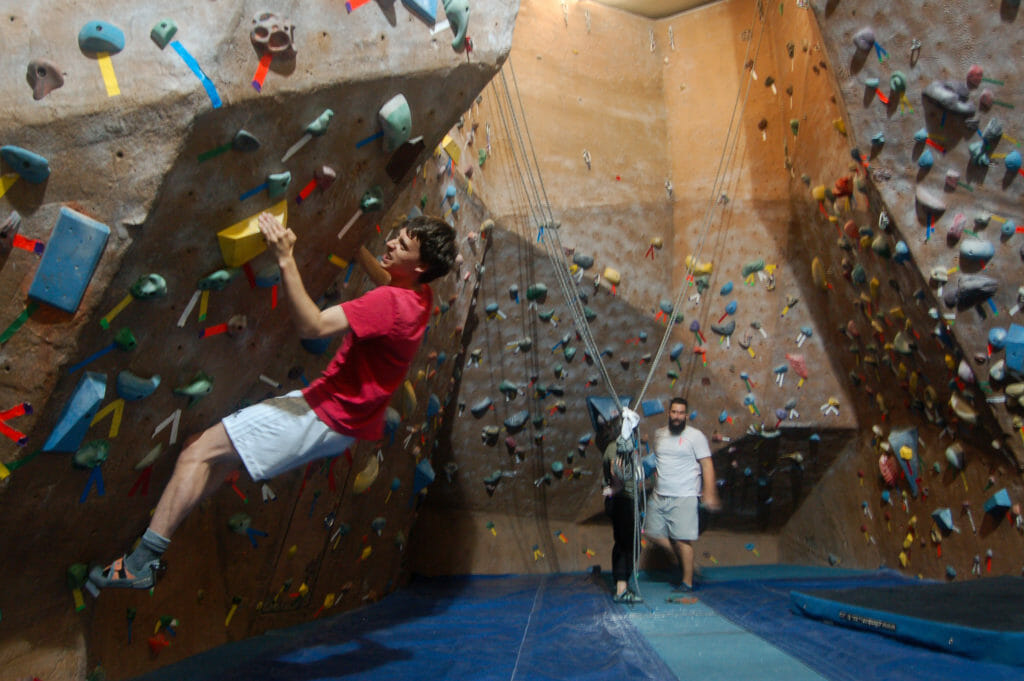
Hitting rock bottom
The rise and fall of climbing at Dalhousie
Correction: The first iteration of our Last on the Bench column contained multiple inaccuracies. As a small newspaper, we encourage our contributors to thoroughly fact-check their pieces and these should have been caught by the writers or editor(s) before print. Below are corrections as provided by Dalhousie Climbing Coordinator Heather Reynolds:
There is no membership fee for access to climbing in the Rock Court. There is an accreditation fee which is not $34, it is $35 plus tax, or $40.25 for Dal students.
Taylor Kilgour has never been a manager in the Rock Court, nor has he been in charge of the setting. He has been a setter and a wall monitor and instructor. The setting schedule was never his responsibility.
For the past 10 years, the staff has had a pattern of changing routes every week during the academic year with some exceptions where the change happens every other week, not a monthly cycle as reported.
The Rock Court continues to maintain the same number of easier routes, typically 36 routes in the novice to intermediate level. There are only about 10 routes at the advanced level; the Rock Court leans toward more of the beginner to moderate level.
Blues routes indicate an intermediate to advanced range of difficulty, so some blues are harder than others. If a climber is used to Kilgour’s setting and now there is a new setter who climbs differently, a blue may feel harder to the user. It does not mean that route is harder. The Rock Court uses multiple people to climb the routes to discuss how the route feels and determine the grade.
You can be forgiven if you don’t know about the Dalhousie Rock Court. Tucked away in the bowels of the Dalplex in a repurposed squash court, the rock climbing centre is one of the facility’s better kept secrets, and until just recently, one of its hidden gems.
Under the leadership of one of the staff members, Taylor Kilgour, the Rock Court was an excellent location for climbers of all levels. Its $35 orientation fee was the best deal in the city for Dalhousie University and University of King’s College students looking to get into climbing, and for those who were already competent and wishing to train more seriously. The selection of routes was extremely diverse for such a small establishment, with dozens of interesting and challenging projects for any skill level. The environment was also second to none. There was of course the odd obnoxious try-hard, but that comes with any sport. That aside there was a laid-back and casual vibe to the place which was simultaneously relaxing and encouraging. In short, the Dalhousie Rock Court was an excellent place to go after class to unwind and train.
Sadly, those days are gone.

Culture shift
After Kilgour’s departure to Ontario midway through the summer to accept a coaching position at Climber’s Rock, an indoor gym in Burlington, the culture at the Rock Court quickly changed. The vacuum left by Kilgour’s absence was filled by a core group of elite climbers who had trained at the gym regularly. As a consequence, the balance of the gym rapidly shifted.
The new Rock Court is an impressively intricate and sophisticated high-performance facility where advanced climbers can fine tune their skills and prepare for competition. For those only looking to climb casually, it’s singularly disappointing. Walls previously filled with routes appropriate for all skill levels have become oversaturated with excessively difficult routes. This leaves new climbers with few routes to feasibly attempt, and fewer still to complete.
To put this into context, there are six levels of routes at the Rock Court. The levels, denoted by different colours of tape, go from white at the easiest to red at the most challenging. In its heyday, average climbers would typically climb at the blue level, the third hardest set of routes. However, on our last trip to the court earlier this month, we witnessed one of the new managers fail at the very beginning of an orange climb, the third easiest.
This disparity of challenge has not gone unnoticed by the Rock Court patrons. The environment has become decidedly competitive and uncomfortable, with some experienced climbers feeling the need to show rookies “the right way to do it,” using the failures of gym patrons as an opportunity to demonstrate their skills in front of an audience.
The in-crowd
This has fostered an “in-crowd” mentality in which the higher echelon of climbers can have a complete run of the gym, ruining its inclusivity. This may sound like a gross exaggeration. However, during our last climb, members of management circled the gym adding holds (the grips on the wall that climbers grab or step on) to routes with which they were struggling. To be clear, there is nothing wrong with adjusting a route that is simply too difficult in its current state. However, what we saw was a manipulation of higher-level routes to suit the needs of the individual climbing at the time, manufacturing that “right way to do it” moment.
Watching someone change a route so they can complete it hardly creates a feeling of respect for the management and further widens the rift between the “in” and “out” crowd.
On the topic of the routes themselves, the rotation of different routes on different walls has taken a turn for the worse. Under Kilgour’s management, there was a set schedule of one of the seven walls being changed each month. This gave climbers time to work on routes which challenged them and progress, but there was still enough change for the walls to always feel fresh. This system seems to have been abandoned. Routes will be there one day and gone the next with no rhyme or reason to the changes.
The Rock Court remains a convenient place for students to climb, but beyond that, it is only a shadow of its former self. We hold out hope that positive changes can be made and that this dark age will be short-lived.






